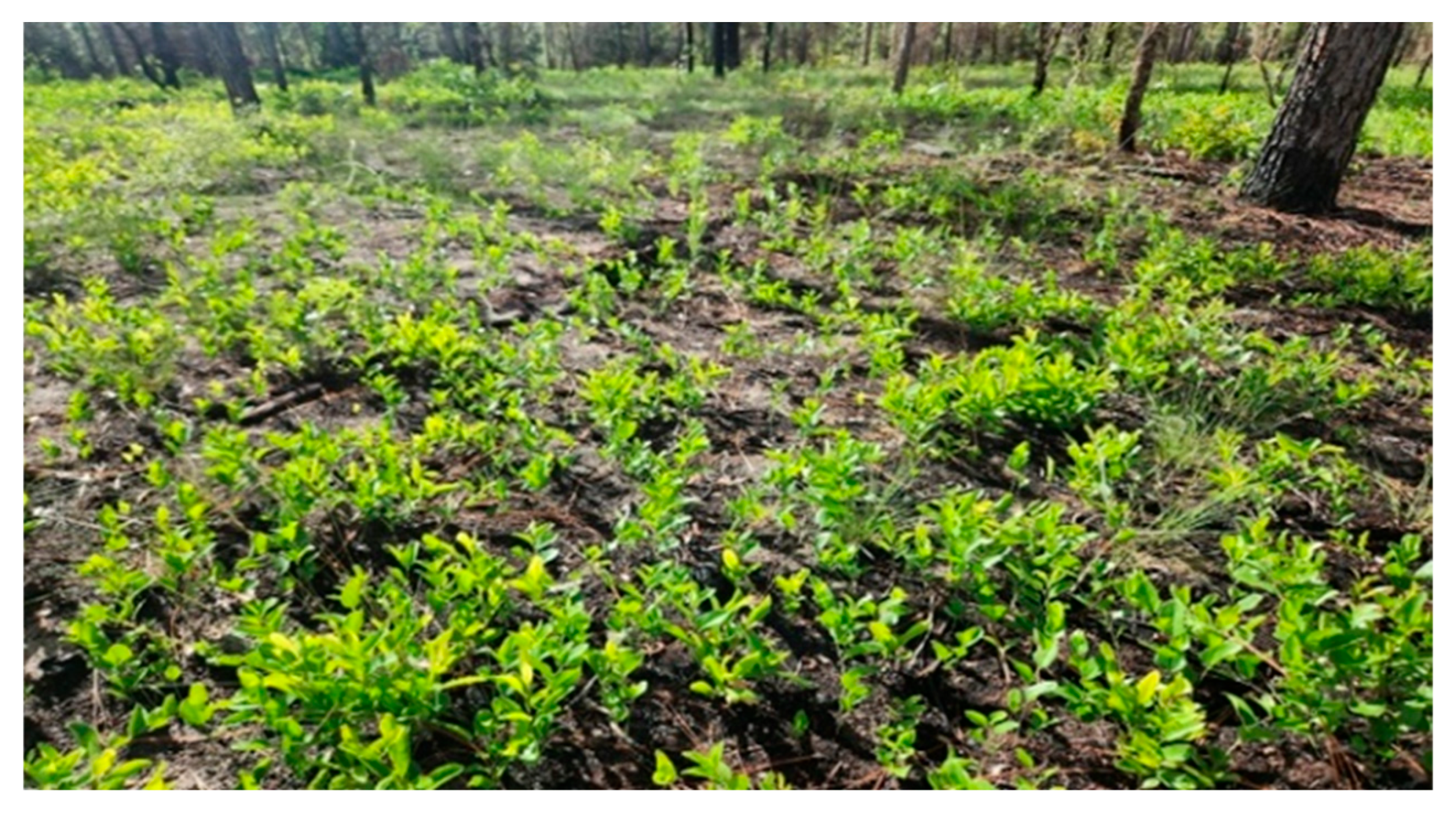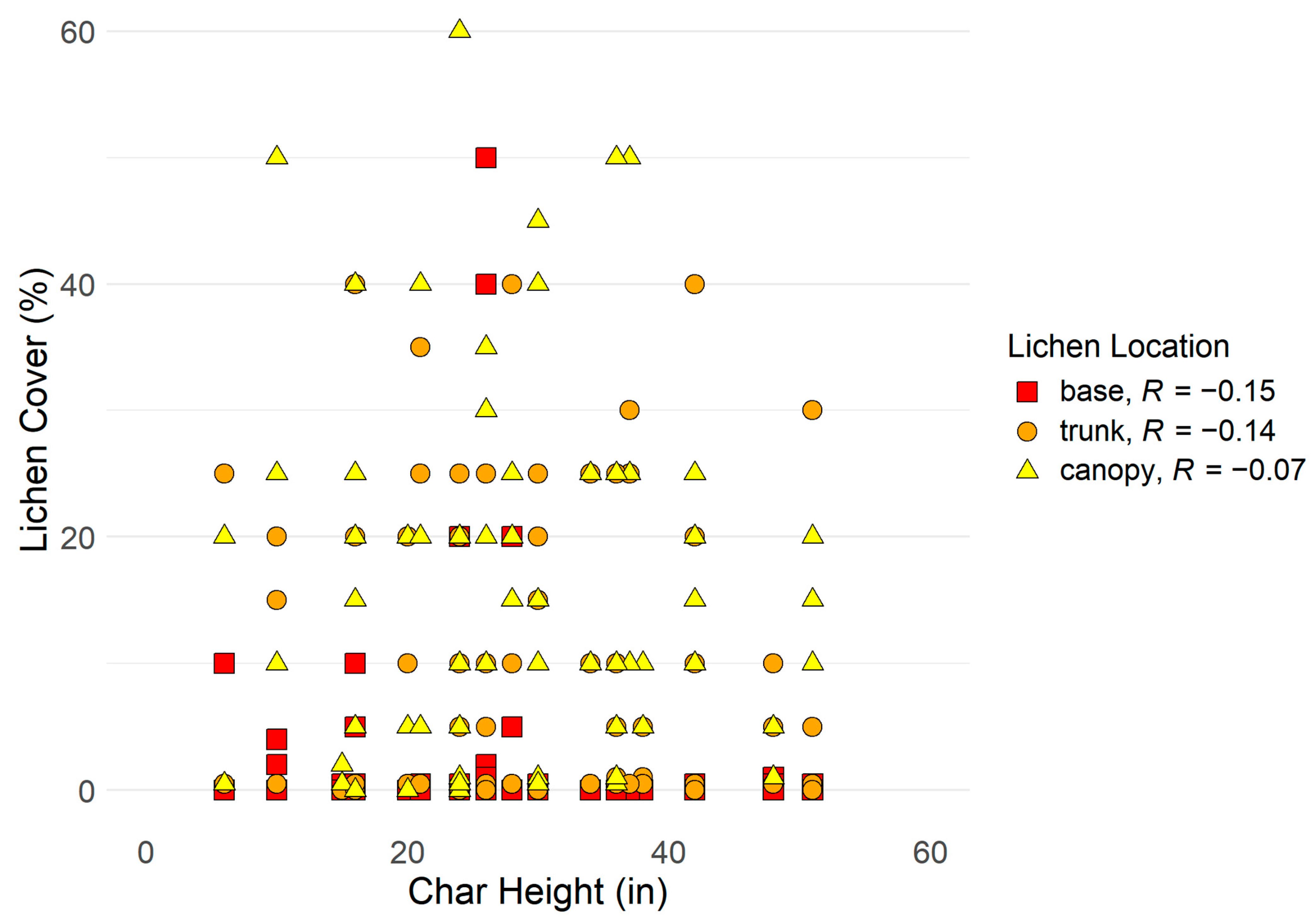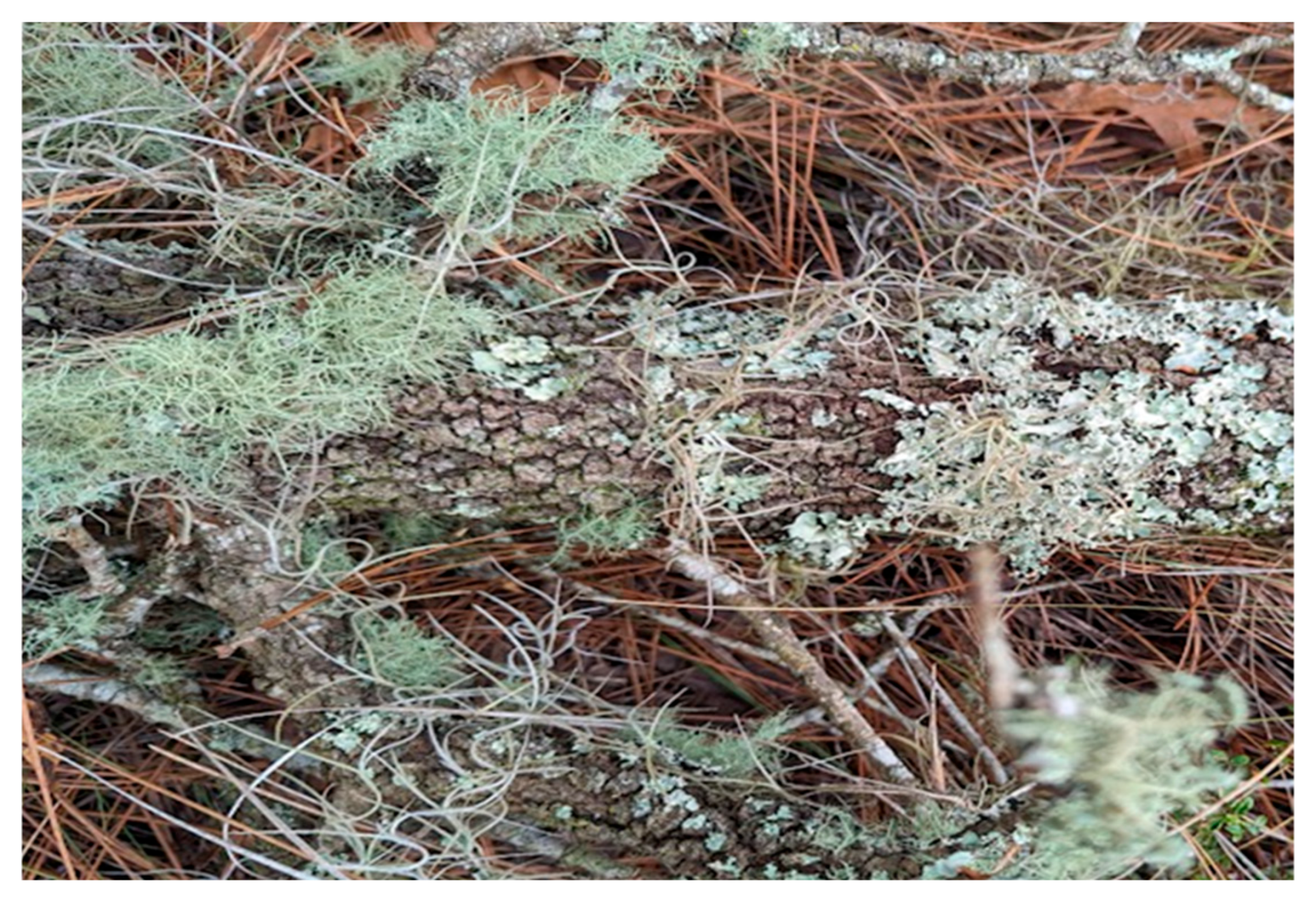Fire Effects on Lichen Biodiversity in Longleaf Pine Habitat
Abstract
1. Introduction
2. Materials and Methods
2.1. Study Area
2.2. Pre-Burn
2.3. Post-Burn
2.4. Post-Burn—Year 2
2.5. Data Analysis
3. Results
3.1. Pre-Burn Lichen Inventory
3.2. Post-Burn Ground Lichens

3.3. Post-Burn Tree Canopy Lichens
3.4. Post-Burn Vascular Vegetation

3.5. Post-Burn—Year 2 Results
4. Discussion
5. Conclusions and Conservation Recommendations for Management
- Maintain some hardwoods within the longleaf pine stand to increase lichen diversity and to serve as refugia for those hardwood-associated lichen species.
- Maintain some tree age and size diversity to encourage greater lichen diversity.
- Create a landscape mosaic that includes some unburned areas within the treatment area.
- Use low-intensity burning rather than high-intensity methods.
- Weather conditions and the resulting fire intensity matter to lichens responding to prescribed fire [28].
- Mechanical clearing around the base of a tree or around a ground lichen colony is the most efficient preparation method to avoid being consumed by fire [54]. This suggests that raking litter away from ground lichen colonies (Cladonia) could be the most practical way to protect them from prescribed fire.
- Retain some standing and dead wood in the forest for lichen diversity.
- Basic lichen floristic surveys and practical applied research into maintaining lichens in the SE US managed forests are needed. Additional work will need to be carried out to elucidate effective strategies for maintaining and restoring lichens in burned portions of longleaf pine habitats.
Supplementary Materials
Author Contributions
Funding
Data Availability Statement
Acknowledgments
Conflicts of Interest
References
- Barnett, J.P.; Dumroese, R.K.; Moorhead, D.J. (Eds.) Proceedings: Workshops on Growing Longleaf Pine in Containers—1999 and 2001; Gen. Tech. Rep. SRS–56; Southern Research Station, Forest Service, U.S. Department of Agriculture: Asheville, NC, USA, 2002; 63p. [Google Scholar]
- Lamont, B.B. Historical links between climate and fire on species dispersion and trait evolution. Plant Ecol. 2022, 223, 711–732. [Google Scholar] [CrossRef]
- Earley, L.S. Looking for Longleaf: The Fall and Rise of an American Forest; University of North Carolina Press: Chapel Hill, NC, USA, 2004; 322p. [Google Scholar]
- Taylor, A.M. Some ecological habitats in the longleaf pine flats of Louisiana. Bull. Torrey Bot. Club 1927, 54, 155–172. [Google Scholar] [CrossRef]
- Lichen Consortium. Available online: https://lichenportal.org/portal/index.php (accessed on 26 August 2025).
- Platt, W.J. Southeastern pine savannas. In The Savanna, Barren, and Rock Outcrop Communities of North America; Anderson, R.C., Fralish, J.S., Baskin, J., Eds.; Cambridge University Press: Cambridge, UK, 1999; 470p. [Google Scholar]
- Peet, R.K.; Allard, D.J. Longleaf pine vegetation of the southern Atlantic and eastern Gulf Coast regions: A preliminary classification. In Proceedings of the Tall Timbers Fire Ecology Conference, No. 18; Hermann, S.M., Ed.; Tall Timbers Research Station: Tallahassee, FL, USA, 1993; pp. 45–81. [Google Scholar]
- Sipman, H.J.M. Diversity and biogeography of lichens in neotropical montane oak forests. In Ecology and Conservation of Neotropical Montane Oak Forests; Kappelle, M., Ed.; Springer Verlag: Berlin/Heidelberg, Germany, 2006; pp. 69–81. [Google Scholar]
- LaGreca, S.A.; Perlmutter, G.B.; Goldman, D.H.; Seavey, F.C.; Seavey, J.L. Lichen diversity on an arborescent runner oak (Quercus pumila) in South Florida, USA. Evansia 2021, 38, 16–26. [Google Scholar] [CrossRef]
- Ellis, C.J. Lichen epiphyte diversity: A species, community and trait-based review. Perspect. Plant Ecol. Evol. Syst. 2012, 14, 131–152. [Google Scholar] [CrossRef]
- Becker, V.E. Nitrogen fixing lichens in forests of the Southern Appalachian Mountains of North Carolina. Bryologist 1980, 83, 29–39. [Google Scholar] [CrossRef]
- Veneklaas, E.J.; Zagt, R.J.; Van Leerdam, A.; Van Ek, R.; Broekhoven, A.J.; Van Genderen, M. Hydrological properties of the epiphyte mass of a montane tropical rain forest, Colombia. Vegetatio 1990, 89, 183–192. [Google Scholar] [CrossRef]
- Pettersson, R.B.; Ball, J.P.; Renhorn, K.E.; Esseen, P.A.; Sjöberg, K. Invertebrate communities in boreal forest canopies as influenced by forestry and lichens with implications for passerine birds. Biol. Conserv. 1995, 74, 57–63. [Google Scholar] [CrossRef]
- Root, H.T.; McGee, G.G.; Norton, R.A. Arboreal mite communities on epiphytic lichens of the Adirondack Mountains of New York. Northeast. Nat. 2007, 14, 425–438. [Google Scholar] [CrossRef]
- Stubbs, C.S. Patterns of distribution and abundance of corticolous lichens and their invertebrate associates on Quercus rubra in Maine. Bryologist 1989, 92, 453–460. [Google Scholar] [CrossRef]
- Wolf, J.H. Non-vascular epiphyte diversity patterns in the canopy of an upper montane rain forest (2550–3670 m), Central cordillera, Colombia. Selbyana 1995, 16, 185–195. [Google Scholar]
- Aptroot, A. Lichenized and saprobic fungal biodiversity of a single Elaeocarpus tree in Papua New Guinea, with the report of 200 species of ascomycetes associated with one tree. Fungal Divers. 2001, 6, 1–11. [Google Scholar]
- Jarman, S.J.; Kantvilas, G. Epiphytes on an old Huon pine tree (Lagarostrobos franklinii) in Tasmanian rainforest. N. Z. J. Bot. 1995, 33, 65–78. [Google Scholar] [CrossRef]
- Spribille, T.; Thor, G.; Bunnell, F.L.; Goward, T.; Björk, C.R. Lichens on dead wood: Species-substrate relationships in the epiphytic lichen floras of the Pacific Northwest and Fennoscandia. Ecography 2008, 31, 741–750. [Google Scholar] [CrossRef]
- Maser, Z.; Maser, C.; Trappe, J.M. Food habits of the northern flying squirrel (Glaucomys sabrinus) in Oregon. Can. J. Zool. 1985, 63, 1084–1088. [Google Scholar] [CrossRef]
- Hale Jr, M.E. Vertical distribution of cryptogams in a virgin forest in Wisconsin. Ecology 1952, 33, 398–406. [Google Scholar] [CrossRef]
- Stevenson, S.K.; Enns, K.A. Integrating Lichen Enhancement with Programs for Winter Range Creation; Ministry of Environment, Lands and Parks, Wildlife Branch: Victoria, BC, Australia, 1992. [Google Scholar]
- Belinchón, R.; Yahr, R.; Ellis, C.J. Interactions among species with contrasting dispersal modes explain distributions for epiphytic lichens. Ecography 2015, 38, 762–768. [Google Scholar] [CrossRef]
- Gustafsson, L.; Eriksson, I. Factors of importance for the epiphytic vegetation of aspen Populus tremula with special emphasis on bark and soil chemistry. J. Appl. Ecol. 1995, 32, 412–424. [Google Scholar] [CrossRef]
- Beckett, R.P.; Minibayeva, F.; Solhaug, K.A.; Roach, T. Photoprotection in lichens: Adaptations of photobionts to high light. Lichenologist 2021, 53, 21–33. [Google Scholar] [CrossRef]
- Lewis, K.J.; Johnson, C.J.; Karim, M.N. Fire and lichen dynamics in the Taiga Shield of the Northwest Territories and implications for barren-ground caribou winter forage. J. Veg. Sci. 2019, 30, 448–460. [Google Scholar] [CrossRef]
- Klein, D.R. Fire, lichens, and caribou. J. Range Mgmt. 1982, 35, 390–395. [Google Scholar] [CrossRef]
- Johansson, P.; Reich, P.B. Population size and fire intensity determine post-fire abundance in grassland lichens. Appl. Veg. Sci. 2005, 8, 193–198. [Google Scholar] [CrossRef]
- Brodo, I.M.; Sharnoff, S.D.; Sharnoff, S. Lichens of North America; Yale University Press: New Haven, CT, USA, 2001; 828p. [Google Scholar]
- Ray, D.G.; Barton, J.W.; Lendemer, J.C. Lichen community response to prescribed burning and thinning in southern Mid-Atlantic coastal plain pine forests, USA. Fire Ecol. 2015, 11, 14–33. [Google Scholar] [CrossRef]
- Whitney, G.G. From Coastal Wilderness to Fruited Plain: A history of Environmental Change in Temperate North America from 1500 to the Present; Cambridge University Press: Cambridge, UK, 1996; 451p. [Google Scholar]
- Ryan, K.C.; Knapp, E.E.; Varner, J.M. Prescribed fire in North American forests and woodlands: History, current practice, and challenges. Front. Ecol. Environ. 2013, 11, e15–e24. [Google Scholar] [CrossRef]
- Peet, R.K. Ecological classification of longleaf pine woodlands. In Longleaf Pine Ecosystem: Ecology, Silviculture, and Restoration; Jose, S., Jokela, E.J., Miller, D.L., Eds.; Springer Series on Environmental Management: New York, NY, USA, 2006; pp. 51–93. [Google Scholar]
- Ray, D.G.; Cahalan, G.D.; Lendemer, J.C. Factors influencing the persistence of reindeer lichens (Cladonia subgenus Cladina) within frequent-fire environments of the Mid-Atlantic Coastal Plain, USA. Fire Ecol. 2020, 16, 1. [Google Scholar] [CrossRef]
- Antos, J.A.; McCune, B.; Bara, C. The effect of fire on an ungrazed western Montana grassland. Am. Midl. Nat. 1983, 110, 354–364. [Google Scholar] [CrossRef]
- Reinhart, K.O.; Menges, E.S. Effects of re-introducing fire to a central Florida sandhill community. Appl. Veg. Sci. 2004, 7, 141–150. [Google Scholar] [CrossRef]
- Holt, E.A.; Severns, P.M. The effects of prescribed burning on wet prairie lichen communities. Nat. Areas J. 2005, 25, 130–136. [Google Scholar]
- Jandt, R.R.; Meyers, C.R. Recovery of Lichen in Tussock Tundra Following Fire in Northwestern Alaska; BLM-Alaska Open File Report 82; Alaska State Office, Bureau of Land Management, US Department of the Interior: Anchorage, AK, USA, 2000; 25p. [Google Scholar]
- Ballard, J. Wildlife habitat management plan. In Proceedings of the Florida Fish and Wildlife Conservation Commission Landowner Assistance Program, Ocala, FL, USA, 1 August 2022; 18p. [Google Scholar]
- McCune, B.; Rosentreter, R.; Ponzetti, J.M.; Shaw, D.C. Epiphyte habitats in an old conifer forest in western Washington, USA. Bryologist 2000, 103, 417–427. [Google Scholar] [CrossRef]
- McCune, B.; Dey, J.P.; Peck, J.E.; Cassell, D.; Heiman, K.; Will-Wolf, S.; Neitlich, P.N. Repeatability of community data: Species richness versus gradient scores in large-scale lichen studies. Bryologist 1997, 100, 40–46. [Google Scholar] [CrossRef]
- Rosentreter, R.; DeBolt, A.; Kaminsky, L. Field Oriented Keys to the Florida Lichens; Boise State University: Boise, ID, USA, 2022; 118p, Available online: https://www.floridamuseum.ufl.edu/herbarium/florida-lichens/ (accessed on 26 August 2025).
- Esslinger, T.L. A cumulative checklist for the lichen-forming, lichenicolous and allied fungi of the continental United States and Canada, version 24. Opusc. Philolichenum 2021, 20, 100–394. [Google Scholar] [CrossRef]
- Broad, K. Lichens in Southern Woodlands; Forestry Commission Handbook No. 4; Her Majesty’s Stationery Office: London, UK, 1989; 48p. [Google Scholar]
- Tallamy, D.W. Bringing Nature Home: How You Can Sustain Wildlife with Native Plants, Updated and Expanded; Timber Press: Portland, OR, USA, 2009; 360p. [Google Scholar]
- Humphrey, J.W.; Davey, S.; Peace, A.J.; Ferris, R.; Harding, K. Lichens and bryophyte communities of planted and semi-natural forests in Britain: The influence of site type, stand structure and deadwood. Biol. Conserv. 2002, 107, 165–180. [Google Scholar] [CrossRef]
- Bayfield, N.G.; Urquhart, U.H.; Cooper, S.M. Susceptibility of four species of Cladonia to disturbance by trampling in the Cairngorm Mountains, Scotland. J. Appl. Ecol. 1981, 18, 303–310. [Google Scholar] [CrossRef]
- Johansson, P.; Wetmore, C.M.; Carlson, D.J.; Reich, P.B.; Thor, G. Habitat preference, growth form, vegetative dispersal and population size of lichens along a wildfire severity gradient. Bryologist 2006, 109, 527–540. [Google Scholar] [CrossRef]
- Pacé, M.; Fenton, N.J.; Paré, D.; Stefani, F.O.; Massicotte, H.B.; Tackaberry, L.E.; Bergeron, Y. Lichens contribute to open woodland stability in the boreal forest through detrimental effects on pine growth and root ectomycorrhizal development. Ecosystems 2019, 22, 189–201. [Google Scholar] [CrossRef]
- Tripp, E.A.; Lendemer, J.C.; McCain, C.M. Habitat quality and disturbance drive lichen species richness in a temperate biodiversity hotspot. Oecologia 2019, 190, 445–457. [Google Scholar] [CrossRef] [PubMed]
- Liu, Y.; Hogan, J.A.; Lichstein, J.W.; Guralnick, R.P.; Soltis, D.E.; Soltis, P.S.; Scheiner, S.M. Biodiversity and productivity in eastern US forests. Proc. Natl. Acad. Sci. USA 2024, 121, e2314231121. [Google Scholar] [CrossRef]
- Root, H.T.; McCune, B.; Neitlich, P. Lichen habitat may be enhanced by thinning treatments in young Tsuga heterophylla-Pseudotsuga menziesii forests. Bryologist 2010, 113, 292–307. [Google Scholar] [CrossRef]
- Menges, E.S.; Kohfeldt, N. Life history strategies of Florida scrub plants in relation to fire. Bull. Torrey Bot. Club 1995, 122, 282–297. [Google Scholar] [CrossRef]
- Williams, B.W.; Moser, E.B.; Hiers, J.K.; Gault, K.; Thurber, D.K. Protecting red-cockaded woodpecker cavity trees predisposed to fire-induced mortality. J. Wildl. Manag. 2006, 70, 702–707. [Google Scholar] [CrossRef]





| Scientific Name | Common Name | Growth Form | Abundance Rating | Preferred Substrate | Reproductive Mode |
|---|---|---|---|---|---|
| Buellia sp. | Button lichen | crustose | R | H | S |
| Buellia stillingiana J. Steiner | Button lichen | crustose | R | P | S |
| Bulbothrix confoederata (W.L. Culb.) Hale | Smooth eyelash lichen | foliose | C | P ** | S |
| Bulbothrix laevigatula (Nyl.) Hale | Matted eyelash lichen | foliose | I | P ** | A |
| Canoparmelia caroliniana (Nyl.) Elix and Hale | Carolina shield lichen | foliose | C | B | A |
| Canoparmelia cryptochlorophaea (Hale) Elix and Hale | Powdery-headed shield lichen | foliose | C | B | A |
| Chrysothrix xanthina (Vain.) Kalb | Sulfur dust lichen | crustose | C | B | A |
| Cladonia evansii (Abbayes) Hale and W.L. Culb. | Powder-puff lichen | fruticose | C ^^ | G | S |
| Cladonia leporina Fr. | Jester lichen | fruticose | C | G and L | S |
| Cladonia parasitica (Hoffm.) Hoffm. | Fence-rail cladonia | fruticose | I ^^ | G and L | A |
| Cladonia peziziformis (With.) J.R. Laundon | Turban lichen | fruticose | Off-plot (R) ^^ | G | S |
| Cladonia rappii A. Evans | Slender ladder lichen | fruticose | Off-plot (I) ^^ | G | S |
| Cladonia ravenelii Tuck. | Ravenel’s cup lichen | fruticose | R ^^ | L | A |
| Cladonia subcariosa Nyl. | Peg lichen | fruticose | I ^^ | G and L | S |
| Cladonia subradiata (Vain.) Sandst. | Powdery peg lichen | fruticose | C ^^ | B | A |
| Cladonia subtenuis (Abbayes) Mattick | Dixie reindeer lichen | fruticose | C ^^ | G | S |
| Dirinaria aegialita (Afz.) B. Moore | Grainy medallion lichen | foliose | I | B | A |
| Dirinaria picta (Sw.) Clem. and Shear | Powdery medallion lichen | foliose | C | B | A |
| Haematomma accolens (Stirt.) Hillm. | Bloodstain lichen | crustose | C | H | S |
| Hypotrachyna livida (Taylor) Hale | Wrinkled loop lichen | foliose | C | H | S |
| Hypotrachyna minarum (Vain.) Elix | Hairless-spined shield lichen | foliose | R | B | A |
| Hypotrachyna osseoalba (Vain.) Y.S. Park and Hale | Grainy loop lichen | foliose | R | H | A |
| Hypotrachyna pustulifera (Hale) Skorepa | Pustulate loop lichen | foliose | R | H | A |
| Hypotracyna spumosa (Asahina) Elix and Hale | Pustuled shield lichen | I | B | A | |
| Lecanora sp. | Rim lichen | foliose | I | B | S |
| Lepraria sp. | Dust lichen | crustose | I | B | A |
| Parmotrema gardneri (C.W. Dodge) Hale | Ruffle lichen (K-, P+ red) | foliose | C | P | A |
| Parmotrema hypoleucinum (J. Steiner) Hale | P+ orange powdered ruffle lichen | foliose | C | P | A |
| Parmotrema perforatum (Jacq.) A. Massal. | UV- perforated ruffle lichen | foliose | C | B | S |
| Parmotrema rampoddense (Nyl.) Hale | Long-whiskered lichen | foliose | C | B | A |
| Parmotrema subisidiosum (Mull. Arg.) Hale | Cracked and salted ruffled lichen | foliose | C | H | A |
| Parmotrema submarginale (Michx.) DePriest and B. Hale | Unperforated ruffle lichen | foliose | C | H | S |
| Parmotrema sulphuratum (Nees and Flotow) Hale | Sulphur ruffle lichen | foliose | R | H ** | A |
| Parmotrema tinctorum (Despr. ex Nyl.) Hale | Palm ruffle lichen | foliose | C | B | A |
| Pertusaria amara (Ach.) Nyl. | Wart lichen | crustose | C | H | A |
| Pertusaria texana Mull. Arg. | Texas wart lichen | crustose | I | H | S |
| Phaeophyscia pusilloides (Zahlbr.) Essl. | Wreath lichen | foliose | I | H | A |
| Physcia sorediosa (Vain.) Lynge | Black-bottomed rosette lichen | foliose | I | H | A |
| Pyxine albovirens (G. Mey.) Aptroot | White rosette lichen | foliose | R | H | A |
| Pyxine caesiopruinosa (Nyl.) Imshaug | Buttoned rosette lichen | foliose | I | H | A |
| Pyxine eschweileri (Tuck.) Vainio | Thin rosette lichen | foliose | I | H | A |
| Trapeliopsis granulosa (Hoffm.) Lumbsch. | Granular mottled-disk lichen | crustose | Off-plot, I ^^ | G and L | A |
| Usnea dimorpha (Mull. Arg.) Mot. | Powder-tipped beard lichen | fruticose | C | H | A |
| Usnea mutabilis Stirt. | Bloody beard lichen | fruticose | I | B | A |
| Usnea rubicunda Stirt. | Red beard lichen | fruticose | C | B | A |
| Usnea strigosa (Ach.) A. Eaton | Bushy beard lichen | fruticose | C | B | A |
| Usnea subscabrosa Nyl. ex Motyka | Horny beard lichen | fruticose | C | B | A |
| Oak Species | Live | Dead—Above Ground | Total | Percent Mortality Above Ground |
|---|---|---|---|---|
| Turkey | 4 | 42 | 46 | 91.3 |
| Water | 2 | 5 | 7 | 71.4 |
| Bluejack | 0 | 2 | 2 | 100 |
| Sand live | Many shrub-like (12) | 0 | 12 | 0 |
| Total | 18 | 49 | 67 | 73.1 |
Disclaimer/Publisher’s Note: The statements, opinions and data contained in all publications are solely those of the individual author(s) and contributor(s) and not of MDPI and/or the editor(s). MDPI and/or the editor(s) disclaim responsibility for any injury to people or property resulting from any ideas, methods, instructions or products referred to in the content. |
© 2025 by the authors. Licensee MDPI, Basel, Switzerland. This article is an open access article distributed under the terms and conditions of the Creative Commons Attribution (CC BY) license (https://creativecommons.org/licenses/by/4.0/).
Share and Cite
Rosentreter, R.; DeBolt, A.; Robb, B. Fire Effects on Lichen Biodiversity in Longleaf Pine Habitat. Forests 2025, 16, 1385. https://doi.org/10.3390/f16091385
Rosentreter R, DeBolt A, Robb B. Fire Effects on Lichen Biodiversity in Longleaf Pine Habitat. Forests. 2025; 16(9):1385. https://doi.org/10.3390/f16091385
Chicago/Turabian StyleRosentreter, Roger, Ann DeBolt, and Brecken Robb. 2025. "Fire Effects on Lichen Biodiversity in Longleaf Pine Habitat" Forests 16, no. 9: 1385. https://doi.org/10.3390/f16091385
APA StyleRosentreter, R., DeBolt, A., & Robb, B. (2025). Fire Effects on Lichen Biodiversity in Longleaf Pine Habitat. Forests, 16(9), 1385. https://doi.org/10.3390/f16091385







